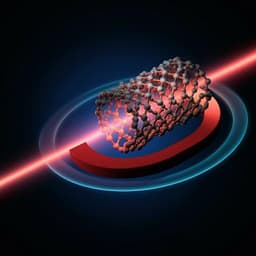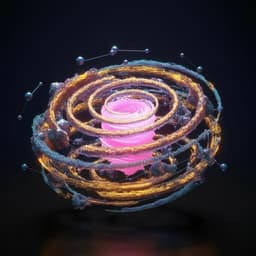
Engineering and Technology
Ultralow-field magnetocaloric materials for compact magnetic refrigeration
P. Liu, D. Yuan, et al.
Unlock the potential of magnetic refrigeration with LiREF₄ single crystals, as proven by the groundbreaking research of Peng Liu and colleagues. Achieving an astonishing magnetic entropy change of 16.7 Jkg⁻¹K⁻¹, this innovative material far outperforms the conventional gallium gadolinium garnet (GGG), revolutionizing technologies around liquid-helium temperatures.
~3 min • Beginner • English
Introduction
The study addresses the need for efficient magnetocaloric materials for ultralow-temperature (near liquid-helium) magnetic refrigeration. The magnetocaloric effect (MCE) is the thermal response of magnetic materials to changes in external magnetic fields; near magnetic phase transitions, magnetic fields can tune the entropy of the magnetic sublattice, and demagnetization results in cooling. Since early demonstrations of adiabatic demagnetization (Debye and Giauque) and the first practical realization to reach 0.25 K, magnetic refrigeration has been widely used for space astrophysical detectors, quantum computing cryogenics, and producing superfluid helium. However, the commonly used GGG requires strong magnetic fields provided by bulky superconducting magnets, and magnetic shielding and low material-to-device volume ratios lead to large, costly, complex systems. The research question is whether rare-earth lithium fluorides LiREF4 single crystals can deliver larger isothermal entropy change (ΔSm) and adiabatic temperature change (ΔTad) under much smaller magnetic fields (≤10 kOe) achievable by permanent magnets, enabling compact, efficient refrigeration around the liquid-helium temperature. The LiREF4 family (RE = Gd, Tb, Dy, Ho, Er, Tm, Yb) crystallizes in the tetragonal scheelite structure with strong magnetocrystalline anisotropy and diverse magnetic ground states, suggesting potential for large conventional and rotating MCEs.
Literature Review
GGG single crystals have long been the benchmark for low-temperature MCE, with early reports of ΔSm ≈ 38 J kg−1 K−1 at 70 kOe and common use in commercial adiabatic demagnetization refrigerators. Despite reports of many low-temperature magnetocaloric materials with large ΔSm, most require strong fields from superconducting magnets, increasing system complexity and cost, particularly when magnetic shielding is needed. Prior work on LiREF4 (including polycrystals) demonstrated promising MCE but limited performance at low fields due to averaging of anisotropy. Specific prior results include ΔSm values up to 44 J kg−1 K−1 for LiGdF4, 25.9 J kg−1 K−1 for LiHoF4, and 17.5 J kg−1 K−1 for LiErF4 at 20 kOe in polycrystals, indicating potential for improved performance with oriented single crystals that exploit high anisotropy.
Methodology
- Materials: Single crystals of LiREF4 (RE = Gd, Tb, Dy, Ho, Er, Tm, Yb) were studied. Crystals possess strong magnetocrystalline anisotropy; the easy axis is parallel to c for LiGdF4, LiTbF4, LiHoF4 and perpendicular to c for LiDyF4, LiErF4, LiYbF4, LiTmF4.
- Magnetization measurements: Zero-field-cooled (ZFC) and field-cooled (FC) magnetization vs. temperature were measured from 2 to 50 K with 100 Oe applied along each compound’s magnetic easy axis (except LiTmF4 measured at 1000 Oe due to weak magnetism). Isothermal magnetization curves were collected from 1.8 to 24 K in fine temperature steps up to 20 kOe, along both easy and hard axes. Single-crystal alignment procedures are referenced to the article’s Methods section.
- Determination of magnetic states: Transitions and magnetic natures were identified: LiTbF4 (FM, Tc ≈ 2.85 K), LiHoF4 (FM, Tc ≈ 1.53 K), LiDyF4 (AFM, TN ≈ 0.62 K), LiErF4 (AFM, TN ≈ 0.38 K), LiYbF4 (AFM, TN ≈ 0.128 K), LiTmF4 (Van Vleck paramagnet), LiGdF4 (paramagnetic in this temperature range; ground state not established here).
- Conventional MCE analysis: Isothermal magnetic entropy change ΔSm(T, H) was computed from isothermal magnetization using the Maxwell relation for field changes of 0→5, 10, and 20 kOe along both easy and hard axes. Thermal and magnetic reversibility were checked via overlap of magnetization/demagnetization curves and ZFC/FC curves.
- Rotating MCE: Rotating entropy change ΔSrot was defined as the difference in ΔSm between orientations with the external field along the easy and hard axes, effectively simulating magnetization by alignment to easy axis and demagnetization by 90° rotation to the hard axis in a static field.
- Direct ΔTad measurements: The adiabatic temperature change was measured directly using pulsed magnetic fields applied along the easy axis for LiTbF4, LiHoF4, and LiDyF4. The sample temperature was recorded as the pulse ramped up to 250 kOe and back to zero under near-adiabatic conditions; ΔTad was taken as Tf − Ts. Low-field behavior of LiHoF4 ΔTad was resolved down to ≤5 kOe at base temperatures around 1.6–4 K.
Key Findings
- Record low-field ΔSm: LiHoF4 exhibits a magnetic entropy change of 16.7 J kg−1 K−1 at only 5 kOe, surpassing GGG (1.0 J kg−1 K−1 at 5 kOe) and all other LiREF4 members under the same field.
- Conventional ΔSm maxima along the easy axis (0→H):
• LiGdF4: 6.6 (5 kOe), 22.5 (10 kOe), 46.7 J kg−1 K−1 (20 kOe)
• LiTbF4: 10.1, 17.9, 21.2 J kg−1 K−1
• LiHoF4: 16.7, 21.7, 25.5 J kg−1 K−1
• LiDyF4: 7.8, 18.9, 24.4 J kg−1 K−1
• LiErF4: 6.7, 16.1, 21.9 J kg−1 K−1
• LiYbF4: 1.7, 6.0, 14.7 J kg−1 K−1
• LiTmF4: 0.04, 0.16, 0.7 J kg−1 K−1 (Van Vleck PM)
• GGG (benchmark): 1.0, 3.9, 14.4 J kg−1 K−1
- Anisotropy and rotating MCE: Strong magnetocrystalline anisotropy yields large rotating MCE. For LiHoF4, ΔSrot reaches ≈16.5 J kg−1 K−1 at 5 kOe, 21.1 J kg−1 K−1 at 10 kOe, and 22.6 J kg−1 K−1 at 20 kOe. Along hard axes, ΔSm is much smaller; for LiDyF4, ΔSm along the hard axis becomes negative at low T due to crystal electric field effects.
- Direct ΔTad:
• LiHoF4: ΔTad ≈ 2.38 K at a base temperature of 1.6 K under 5 kOe; adiabatic removal of 5 kOe around 4 K cools to ≈1.6 K. Cycling magnetization/demagnetization ΔTad traces coincide, indicating reversibility.
• LiTbF4: ΔTad up to ≈30 K at 4.2 K under high pulsed fields, with saturation tendency consistent with FM nature and Tc ≈ 2.85 K.
• LiDyF4: ΔTad increases without saturation under high fields, consistent with AFM behavior.
- Reversibility: ZFC/FC curves overlap for all compounds; magnetization/demagnetization curves overlap, indicating excellent thermal and magnetic reversibility.
- Practical implication: Performance of LiREF4 single crystals nearly saturates at low fields (5–10 kOe), enabling the use of compact permanent magnets instead of superconducting magnets.
Discussion
The findings demonstrate that LiREF4 single crystals, especially LiHoF4, deliver superior magnetocaloric performance to the GGG benchmark under ultralow magnetic fields. The combination of large ΔSm and sizable direct ΔTad at fields achievable by permanent magnets directly addresses the bottlenecks of current adiabatic demagnetization systems that rely on bulky superconducting magnets and extensive magnetic shielding. Strong magnetocrystalline anisotropy enables large rotating MCE by simple 90° rotation between easy and hard axes in a static field, offering a compact route to implement magnetization/demagnetization cycles. Because ΔSm and ΔTad effectively reach near-saturation at 5–10 kOe, material quantity and magnet size can be reduced, decreasing device footprint and cost while easing magnetic shielding requirements. The excellent thermal and magnetic reversibility across the LiREF4 family supports cyclic operation and reliability. Overall, these results validate LiREF4 single crystals as promising working media for compact magnetic refrigerators operating around liquid-helium temperatures.
Conclusion
This work establishes LiREF4 single crystals as ultralow-field magnetocaloric materials capable of compact magnetic refrigeration near liquid-helium temperatures. LiHoF4 achieves a record ΔSm of 16.7 J kg−1 K−1 at 5 kOe and a direct ΔTad of ≈2.38 K under 5 kOe, with large rotating MCE values up to 22.6 J kg−1 K−1 at 20 kOe. Across the LiREF4 series, strong anisotropy, high reversibility, and near-saturation of performance at 5–10 kOe suggest that efficient refrigerators can be built using permanent magnets, reducing system size, mass, and complexity relative to superconducting-magnet-based systems. Future work could focus on engineering device architectures that exploit rotating MCE, optimizing crystal orientation and thermal interfaces, extending measurements to lower temperatures and continuous-field conditions, and exploring other RE compositions or doping strategies to further enhance low-field ΔSm and ΔTad.
Limitations
- Measurement temperature range: Magnetization and ΔSm measurements were performed down to 1.8 K, leaving the LiHoF4 Tc (≈1.53 K) just below the measured range, and potentially underestimating peak features at lower T.
- Incomplete ground-state information: The magnetic ground state of LiGdF4 remains unresolved.
- Orientation and anisotropy dependence: Performance relies on single-crystal orientation; polycrystalline performance at low fields is limited due to anisotropy averaging.
- Device-level validation: While low-field ΔSm and direct ΔTad are demonstrated, integrated device demonstrations and long-term cycling under operational heat loads were not reported in the provided text.
Related Publications
Explore these studies to deepen your understanding of the subject.







